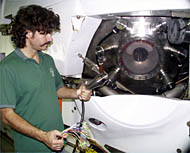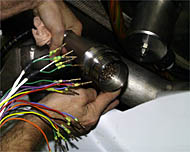|
|
  TODAY'S WEATHER Latitude: 18deg 38’ 53” N Longitude: 104deg 24’ 42” W Wind Direction: NW Wind Speed: 14.5 Knots Sea State 2 Swell(s) Height: 1 Foot Sea Temperature: 83°F (28.6°C) Barometric Pressure: 1014.3 MB Visibility: 10 Nautical Miles
January 28, 2000 By Dr. Dan Fornari Daybreak saw the RV Atlantis steaming at almost 13 knots through near glassy seas, scattering flying fish by the dozens as it headed to the dive site on a course of 185°. All the scientists on board are getting used to the routine of life at sea, learning when meals are served, and getting acquainted with the ship’s crew. Patrick Hennessy has the trolling lines out but so far no fish has hit the lines, probably because we are going so fast. Interestingly, we’ve heard that the fishing out in this area of the Pacific has not been very good the past few years because of El Nino. We’ll be able to tell first hand when we get to the dive site and the fishermen among us break out their rods and reels! Today, graduate students, Greg Kurras, Jenny Engels and Del Bohnenstiehl worked hard at preparing the Towed Camera Sled for the night-time surveys it will do. This camera sled is a much simpler version of the Argo towed mapping system operated by the Woods Hole Oceanographic Institution for many scientists [Click here to learn more about ARGO]. Argo is able to send up four video signals, sonar data, and loads of other types of information to scientists on board a ship so they can look at, and map the seafloor as they are driving over it. It can even steer around a bit using its 2 thrusters. The Towed Camera, on the other hand, has affectionately been called a “Dope on a Rope” because it does not have any of the “smart” features of the fiber optic based Argo. The Towed Camera Sled does a good job though by collecting photographs of the seafloor that scientists can use for their research. It has a deep sea digital camera made by Benthos, Inc. of North Falmouth, MA, a well known manufacturer of deep ocean cameras and equipment. Dan Fornari has been working with Bill Hersey , an engineer at Benthos to develop this camera over the past few years. This camera takes 2300 black & white digital pictures on each lowering to the seafloor and stores them on a 4 Gigabyte (a Gigabyte is 4 billion bytes of information!) hard drive in the computer that is built into the system. The camera uses 2 high-power strobes (600 watt/sec) for lighting. The sled is towed about 7 meters (23 feet) above the seafloor and scientists onboard Atlantis are able to tell how high it is above the rocky bottom by using a pinger. The pinger makes a sound that is bounced off the seafloor and also travels directly to the ship. The two sound pulses (the direct one and the bounced one) are received by a hydrophone, an underwater listening device on the hull of the ship, and fed into an amplifier to make a record on a screen. The separation between the two pulses tells us how far off the ocean floor the camera is. Sometimes, if the seafloor is very rough it is hard to keep from hitting. That’s why the Camera Sled is so sturdy! After the tow, when the camera is back on board Atlantis, the students will transfer the images from the camera to computer disks and then analyze them. We’ll hear a lot more about the discoveries that the Towed Camera Sled will make in the days to come. We are hoping to do a first test lowering tomorrow night. Briefing the scientists who will be diving on this cruise continued today as the Alvin crew kept doing their routine maintenance of the submarine as well as checking all the wiring and operation of the gravimeter, magnetometer and another Benthos digital camera (this one takes color photographs) that will be used during the dives. One important task that the crew has to do when a new science party comes on board and installs new equipment is making sure that there are no grounds in the electrical systems (Read more about the electrical system in Alvin) Because Alvin operates on batteries, and because it dives in the ocean where the salt water easily conducts electricity, they have to be very careful about how the electricity flows in all the equipment that is operated in the sub. so that it is safe and not wasted. It takes a lot of time, patience, and knowledge to do this correctly. Tomorrow we plan to launch transponders in the morning, and survey-in their positions so that we have good navigation for Alvin when it dives on Sunday.
|
||||||||||||||||||||||||||||||||||||||||||||||||||||||||||||||||
© 2010 Dive and Discover™. Dive and Discover™ is a registered trademark of
Woods
Hole Oceanographic Institution



